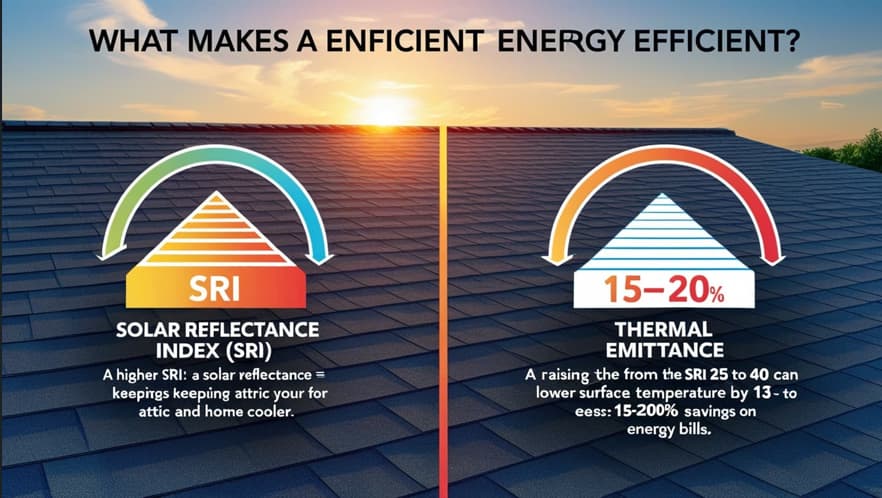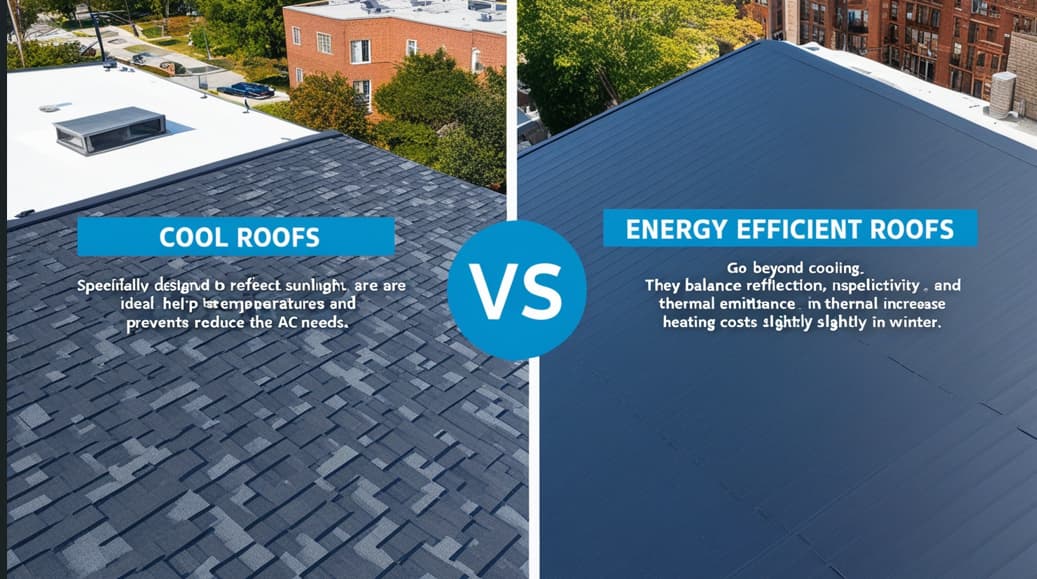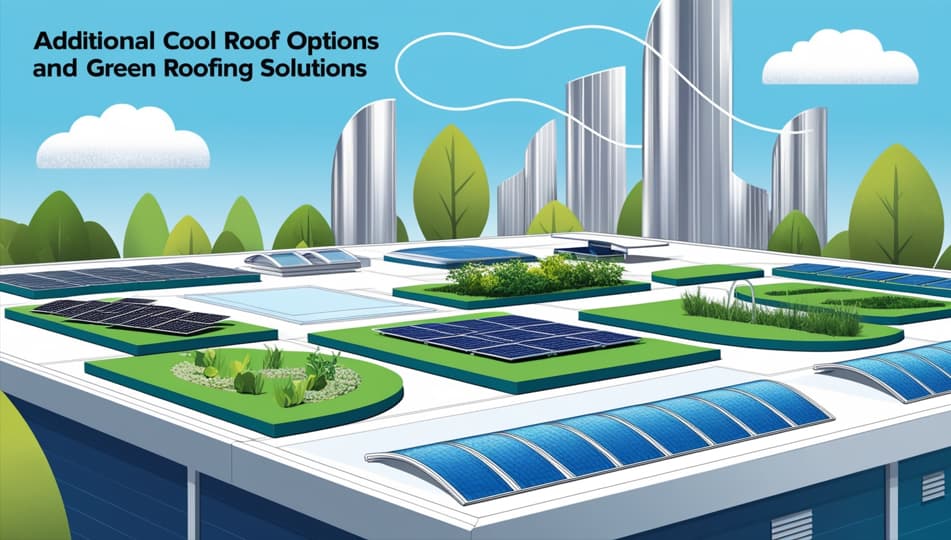Roofing
Energy Efficient Roofing: Your Guide to Savings and Comfort
Energy efficient roofing is a powerful tool for reducing energy costs and improving home comfort. While most people consider energy-efficient appliances, windows, and light bulbs, roofs are often overlooked. However, energy efficient roofing can save homeowners hundreds of dollars each year.
This article will cover everything you need to know about energy efficient roofing, from the basics of how it works to practical tips on choosing the best options for your home.
Whether you’re looking to upgrade or install a new roof, understanding energy efficient roofing can make a big difference in your wallet and comfort.
1. What Makes a Roof Energy Efficient?
What makes energy efficient roofing effective? It primarily comes down to two factors: Solar Reflectance Index (SRI) and thermal emittance.
- Solar Reflectance Index (SRI): SRI measures how well a roof reflects sunlight, keeping surfaces cooler. A higher SRI indicates better reflectivity, keeping your attic and home cooler.
For example, raising the SRI from 25 to 40 can lower the roof surface temperature by 13 degrees, leading to 15–20% savings on energy bills.
Thermal Emittance: This measures how efficiently a roof releases absorbed heat. High thermal emittance prevents heat buildup in the roof, keeping your indoor space cooler.
Energy efficient roofing reflects solar energy and emits heat effectively. Look for light colors or specialized coatings to boost reflectivity, and consider materials rated for high thermal performance.
These features ensure your roof does its job to reduce energy transfer and save you money. Ready to upgrade to an energy-saving roof? Find your ideal solution here.
2. Benefits of Energy Efficient Roofing
Why should you consider energy efficient roofing? The benefits are substantial, both for cost savings and comfort.
- Lower Energy Bills: An energy-efficient roof can reduce air conditioning needs by reflecting heat away from your home, cutting energy bills by up to 25%.
- Longer Roof and HVAC Lifespan: Less heat on your roof means less strain on your HVAC system, extending its life and saving you money on repairs.
- Improved Comfort: Cooler roofs contribute to stable indoor temperatures, making spaces more comfortable without extra AC.
- Environmental Impact: Reduced energy consumption means a smaller carbon footprint, contributing positively to the environment.
With these benefits in mind, it’s clear that energy efficient roofing isn’t just a smart choice for your wallet—it’s a choice that can enhance your quality of life and protect the environment. Explore top roofing options that boost efficiency! See the best choices here.
3. Types of Energy Efficient Roofs
When considering energy efficient roofing options, several materials stand out.
- Metal Roofs: These are top choices for energy efficiency. They’re reflective, durable, and can last over 50 years with minimal maintenance.
- Tile Roofs (Clay and Concrete): Tile roofs naturally reflect heat, and airflow beneath the tiles enhances cooling. With reflective coatings, they perform even better.
- Asphalt Shingles: While traditional asphalt absorbs heat, newer shingles with reflective granules increase efficiency. Look for Energy Star-rated options for the best performance.
For a quick comparison:
| Roof Type | Pros | Cons |
| Metal | Highly reflective, durable | Higher upfront cost |
| Tile | Reflective, allows airflow | Heavier, may need extra support |
| Asphalt Shingles | Affordable, widely available | Less efficient without treatment |
Choosing the right roof type for your needs depends on factors like climate and budget. Each option offers unique benefits, and finding the right one can maximize your energy savings and comfort. Looking for the perfect energy-efficient roof? Discover options tailored to your needs here.
4. Comparing Cool Roofs and Energy Efficient Roofs
Cool roofs and energy efficient roofing often overlap but are slightly different.
- Cool Roofs: Specifically designed to reflect sunlight, cool roofs are ideal for warm climates and help reduce AC needs. They lower indoor temperatures and prevent heat buildup, especially useful for urban areas. However, they may increase heating costs slightly in winter.
- Energy Efficient Roofs: These go beyond cooling. They balance insulation, reflectivity, and thermal emittance for year-round savings.
For instance, cool roofs may suit warm regions, while energy-efficient options work better in mixed climates. Check with your roofer to determine which option fits your needs best.
| Roof Type | Best For | Drawbacks |
| Cool Roof | Hot climates | Potential winter heating penalty |
| General Energy Efficient | Year-round savings potential | May cost more upfront |
Ready to save on energy bills? Check out affordable, efficient roofing solutions here.
5. How to Choose the Right Energy Efficient Roof for Your Home
Selecting the right energy efficient roofing involves several factors:
- Climate and Weather: If you live in a hot area, prioritize high SRI ratings. For colder climates, consider energy-efficient options that balance insulation and reflectivity.
- Roof Type and Slope: Steep roofs (over 2:12 pitch) work best with shingles and tiles, while low-slope roofs benefit from membranes and coatings.
- Budget: Compare short-term installation costs with long-term savings. Many energy-efficient roofs save money over time, making the initial investment worthwhile.
- Ventilation: Proper ventilation aids in cooling, supporting the roof’s efficiency and helping prevent attic heat buildup.
Whether upgrading or starting fresh, keeping these points in mind helps you select the best energy efficient roof for your specific needs.
6. Energy Efficient Roofing Materials for Different Roof Slopes
Energy efficient roofing materials vary based on roof slope:
- Steep Roofs (Pitch > 2:12): Asphalt shingles with reflective granules, metal, and clay tiles are top choices. Each option offers unique cooling benefits, keeping your home comfortable.
- Low-Sloped Roofs (Pitch ≤ 2:12): Single-ply membranes, built-up roofs, and modified bitumen are effective for low slopes. These materials are usually applied as flat sheets with reflective coatings.
Understanding your roof slope and available materials helps you pick the right energy efficient solution.
7. Additional Cool Roof Options and Green Roofing
Cool roofs come in various options, from light-colored asphalt shingles to coatings for existing roofs. Light colors reflect more heat, with white options reducing temperatures significantly.
Another option, green roofing, uses vegetation to insulate and cool buildings. While it’s an effective choice for urban areas, green roofs can be costly to install and require regular maintenance. Before opting for green roofing, consider the structure and climate suitability.
Green roofs also provide added insulation, making them an effective yet unique approach to energy efficient roofing.
8. Cost and Energy Savings: Is Energy Efficient Roofing Worth It?
Cost and energy savings vary with different types of energy efficient roofing.
- Initial Cost vs. Savings: Metal and tile roofs may have higher upfront costs but save more on energy in the long run.
- Potential Rebates and Tax Credits: Many areas offer financial incentives for energy-efficient roofs, helping you recover installation costs faster.
- Example Cost Table: A basic comparison of costs and savings.
| Roofing Type | Initial Cost | Yearly Energy Savings | Rebates Available? |
| Standard Asphalt | Low | Low | No |
| Metal | High | High | Yes |
Weighing costs and savings will help you decide if energy efficient roofing fits your needs.
Conclusion:
Energy efficient roofing offers a range of benefits, from reduced energy costs to increased comfort. Choosing the right roof type for your climate, budget, and preferences is essential to maximize your savings and comfort.
With a variety of materials available, energy efficient roofing is accessible to nearly everyone looking to make a smart investment in their home. Which type of energy efficient roofing do you think is right for your home?
Please like, comment, and share this article if you found it helpful!
Recent Posts
- Roof Repair Products: You Need to Fix Leaks Quickly
- Roof Repair: Quick Tips to Fix Common Issues
- Hip Roof Design: A Comprehensive Guide
- Hip Roof Framing: A Comprehensive Guide
- Hip Roof vs. Gable Roof : Which One is Best for Your Home?










I quite like looking through a post that can make people
think. Also, many thanks for allowing me to
comment!